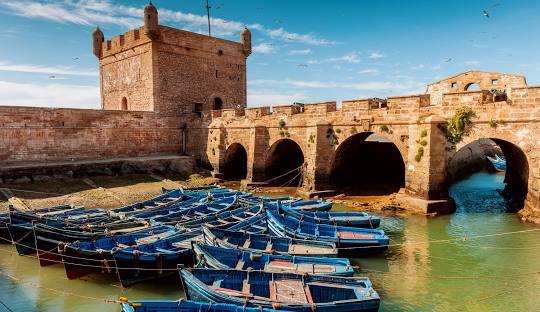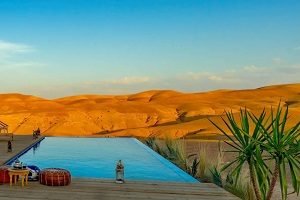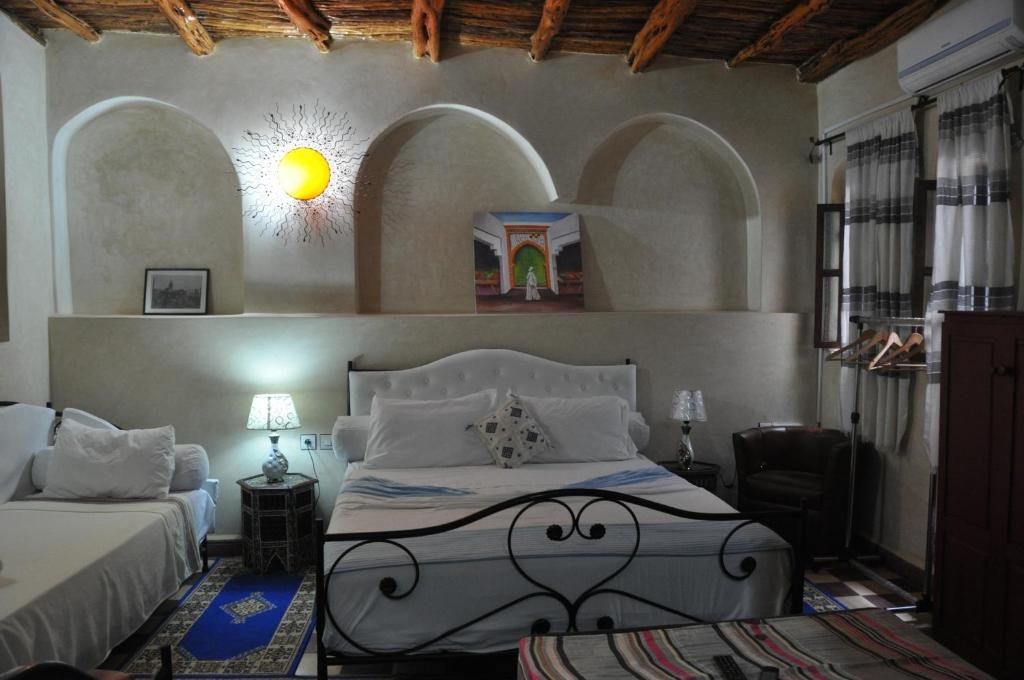Watercolor Workshops in Southern Morocco with Hans Christian Sanladerer
Home ➞ Artist’s Retreat ➞ Travel Sketcher

Hans-Christian Sanladerer
Born and raised in Garmisch-Partenkirchen, a picturesque village at the bottom of the Upper Bavarian Alps the now passionate sketcher of all things, workshop tutor and book author studied Graphic Design at the Academy of Fine Arts in Nürnberg and Illustration at Parsons School of Design in New York. He created illustrations, cartoons and satirical paintings for newspapers and magazines, designed board and card games as well as many patterns for porcelain and stationary. He freelanced for one of Germany’s leading broadcasting companies as their newspaper designer. As head of a multi-cultural design department for Europe’s leading wall covering company he designed wall coverings for the worldwide market. After an education as an online editor, he created and maintained website and social media content for diverse clients. For many years now his life has been fully dedicated to the daily practice of sketching, be it urban sites, nature, people, animals or … you name it. He loves to pass on his various experiences to people of all knowledge levels via daily on-location workshops as well as online classes and art travels to beautiful places, such as Morocco, to share with you the habit of daily sketching to enhance your life experience.
Terms
Workshop Trip 8 days / 7 nights all inclusive:
This price includes:
– More than 20 hours of lessons spread over 8 days for a maximum group of 15 people
– Airport / Hotel transfers
– (air-conditioning) 17-seater vehicle with driver
– official licend tourist guides
– Full board accommodation, double room or Twin for couples (all rooms have a private bathroom)
Accompanying Person Trip 8 days / 7 nights all inclusive:
– Full board accommodation, double room or Twin for couples (all rooms have a private bathroom)
– Airport / Hotel transfers
– (Air-conditioning) 17-seater vhicle with driver
– Official licend tourist guides
– Tourist taxes to be paid on site
– Roundtrip flights to Marrakech
– Painting equipment
– On-site purchases.
– Cocktails / henna party
-Traditional hamam
– Entrance fees to monuments
Traditional Dishes
One of the most notable aspects of Moroccan cuisine is the emphasis on the quality and freshness of ingredients. The produce is sourced from a land free of pesticides, chemicals, hormones, or preservatives. Animals are typically slaughtered just hours before they are used, with mutton being the prevalent meat offered, rather than lamb. Market vegetables are freshly gathered each morning. The use of spices, herbs, fresh fruits, nuts, and dried fruits imparts an invigorating vitality that stands in stark contrast to the packaged and imported products commonly found in much of Europe and North America.
To further acquaint you with the culinary delights, here are explanations of some of the most common and popular traditional Moroccan dishes:
Harira: A thick soup made of chickpeas, lentils, and haricot beans, often flavored with mutton or chicken, lemon, and tarragon.
Brochettes: Grilled kebabs featuring mutton, liver, and fat.
Kefta: Spicy meatballs crafted from minced mutton and offal, often served in a seasoned sauce.
Pastilla/Bastilla: A pie composed of multiple layers of flaky pastry filled with chopped pigeon meat, eggs, almonds, and spices. Chicken or fish may be used as alternatives to pigeon.
Tagine: Alongside couscous, this is one of the most ubiquitous Moroccan dishes—a slowly simmered stew cooked in its own juices in an earthenware bowl with a distinctive conical lid. Variants include tagine de viande (mutton stew with vegetables or served alone with prunes), tagine de poisson (bream or sardine stew with tomatoes and herbs), tagine de lapin (rabbit stew), and tagine de poulet aux olives et citron (a delicious chicken stew with lemon and olives). The lemon imparts a delightful bitter zest to the meat.
Mechoui: Lamb roasted whole on a spit or baked in a special oven. This delicately fragrant meat, distinct from typical mutton, is often enjoyed with bread but is considered an elaborate luxury that may need to be ordered well in advance.
Couscous: Made from half-baked flour ground into semolina-like grains, perfectly prepared couscous involves a meticulous cooking process with steamings and oilings, resulting in distinct granular texture. While best enjoyed in a home or a quality restaurant, it is often served with sept légumes (seven steamed vegetables) and occasional mutton. Couscous can also be served as a dessert with sugar, cinnamon, and rich, warm goat's milk.
Cornes de Gazelle: Croissant-like pastries filled with honey and almonds.

Why you will love this trip in : Essaouira
Essaouira gained UNESCO status thanks to it being a prime example of an 18th-century fortified town. The city walls are an incredible reminder of its past, the medina inside still very much a part of its present. The harbor is chock full of traditional fishermen's boats, and you'll catch them (the fishermen—not the boats) hauling in their catch or mending their nets on the regular. The entire port is ridiculously picturesque, in that gritty, nostalgic kind of way. To get into Essaouira's history, carve out ample time in your itinerary to just wander. You likely won't get too lost—the streets are linked in such a way that you're never too far from the main thoroughfare running through its center, the spine of the medina. It stretches from the North Gate, Bab Doukkala, all the way to Place Moulay Hassan, by the waterfront. Little sandstone passageways, grand stone gates, pungent stalls selling everything from mint tea and colorful silks to live chickens; there's no better way to ingratiate yourself with the city. And once you reach the harbor, don't shy away from being social. Small blue and white gargottes are selling the fresh catch of the day, and the fishermen will quite likely fight over your patronage. You can also sample oysters down here. Back in the citadel, also consider walking up. You pay a nominal fee to go up the ramparts, where you'll catch a view of the harbor and Île de Mogador from above. This is an excellent spot to catch the sunset, by the way. Our services Lodging : Riad, guest house. Technical support and overall support during all your travels.
- Essaouira - Safé - Marrakech
- 02nd to 09th June 2025
- Summer Sketching - nice and easy
- Let me take you on a trip to create sunny summer sketches in beautiful Essaouira. We will capture the beauty of this unique place full of energy by drawing with different media, watercolor painting and all kinds of combinations, mixed media. „Motifs are everywhere“. We will enjoy capturing the ancient town buildings, Market places, coastal landscapes and cultural venues. We’ll exchange our stories enjoying fantastic food. In this course we will deal with the basic aspects of Urban and Nature Sketching as well as the details. How do we find our motifs? Which excerpt will be put on paper? How do we best reduce to the most essential parts of the picture? Sketching isn’t about perfection. It is basically about capturing the atmosphere of the scenery in your personal style - with fun. Together we will look closely at the many shades of the beautiful colours of Morocco. We will observe light and shadow, learn how to create 3-dimensionality with tone values, where to start a sketch and when to end it … I will show you how to create a story of your trip in sketches, create beautiful spreads on double pages and add typography to give your sketch a nice finish. You want to learn more about me and my art? Have a look at my instagram or facebook accounts: @illuchrisa. Sketchers or sketchers-to-be from all over the world are welcome to join to deep dive into the world of sketching. This workshop includes much more than the techniques of sketching, it provides a priceless wholesome and lasting life experience you would not want to miss.
- Essaouira offers a excellent setting for painting
- It's the beach time.... its purpuraire islands, harbor and its multiple blue boats. its souks, craftsmen and its surrounding countryside will be among the many subjects for your paintings. the main goal is to make you happy by discovering the daily life of the locals and the charm of the narrow Alleys. as well as making from your own sketching a unique souvenir notebook. On the itinerary for these 8 days or more : walks, theoretical notions, presentations, practice, quick watercolors sketches on the pattern. Targeted outings and day or half day excursions to paint and seek out atmospheres of colors, where blue will be in the spotlight, no doubt! At the end of the week, sum up of your travel book (with or without my advice) by adding the various materials, newspapers, papers, plants, herbs, etc. that you will have gathered over the days.
- Program

“Upon arrival in Marrakech, participants will be welcomed by our professional guide and driver. We will then depart for Essaouira by a 17-seat bus, with a short stop to inaugurate the travel log.”

A walk into the walls of the medina (fortresses). Painting and sketching time. Lunch break. In the afternoon, discover the city and sketch in the shaded streets.
OverNight in Essaouira.


First excursion to the Souk d’ Had Draa, a large Sunday regional market where breeders and merchants do their business selling animals, clothes, unusual materials, spices, meat, fruit and vegetables….etc… A total immersion and occassion to take our first mint tea under a tent. Return to the gite at the end of the afternoon. Night in Essaouira.

Walk on the immense beach of Essaouira, panoramic sketch.

After lunch break, You Continue to explore Les Dunes de Guemassa, our haven of peace in Chichaoua, just 10 minutes from Agafay. It’s the perfect place to pause time and immerse yourself in another universe.

You will spend the Morning in the Riad in order to finish the travel log, diverse collages, layout of the pages with advice of the teacher.

Departure to the aireport


